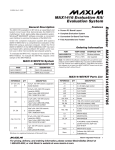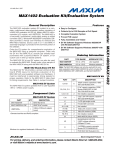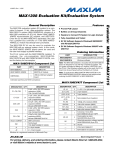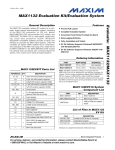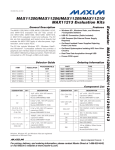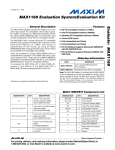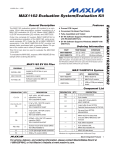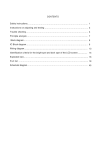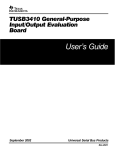Download Maxim MAX1415EUE User guide
Transcript
19-3084; Rev 1; 5/07 MAX1416 Evaluation Kit/Evaluation System The MAX1416 evaluation kit (EV kit) is an assembled and tested printed-circuit board (PCB) that demonstrates the MAX1416 multichannel, 16-bit, sigma-delta data-acquisition system. Windows® 98/2000/XP-compatible software provides a convenient user interface to exercise the features of the MAX1416. Order the complete evaluation system (EV system) (MAX1416EVC16) for a comprehensive evaluation of the MAX1416 using a personal computer. Order the EV kit (MAX1416EVKIT) if the 68HC16MODULE-DIP has been purchased with a previous Maxim EV system, or for custom use in other microcontroller (µC)-based systems. To evaluate the MAX1415, request a free sample of the MAX1415EUE. To evaluate the MX7705, request a free sample of the MX7705EUE. Component Lists MAX1416 EV System PART QTY DESCRIPTION MAX1416EVKIT 1 MAX1416 evaluation kit 68HC16MODULE-DIP 1 68HC16 µC module USBTO232+ 1 USB-to-COM port adapter board +Denotes lead-free and RoHS-complaint. Features ♦ Proven PCB Board Layout ♦ Complete Evaluation System ♦ Convenient On-Board Test Points ♦ Fully Assembled and Tested ♦ EV Kit Software Supports Windows 98/2000/XP with RS-232/COM Port ♦ EV Kit Software Supports Windows 2000/XP with USB Port Ordering Information TEMP RANGE INTERFACE TYPE MAX1416EVC16 PART 0°C to +70°C* Windows software MAX1416EVKIT 0°C to +70°C* User supplied *This limited temperature range applies to the EV kit PCB only. The MAX1416 IC temperature range is -45°C to +85°C. Note: The MAX1416 software is designed for use with the complete EV system (MAX1416EVC16). It includes a 68HC16MODULE-DIP module, USBTO232, and a MAX1416EVKIT. If the MAX1416 evaluation software is not used, the MAX1416EVKIT board can be purchased by itself, without the µC. MAX1416 EV Kit DESIGNATION C1–C4, C10, C11 C5 C6 C7, C8 C9, C12, C13 C14 QTY DESCRIPTION DESIGNATION QTY 6 0.01µF, 10V X7R ceramic capacitors (radial leaded) H1 1 8-pin header J1 1 2 x 20 right-angle socket JU1 1 2-pin header 1 0.01µF ±10%, 50V X7R ceramic capacitor (0603) Taiyo Yuden UMK107B103KZ TDK C1608X7R1H103KT JU2 1 2-pin header JU3 1 3-pin header JU4 1 2-pin header R1–R4 4 10Ω ±5% resistors (axial leaded) R5, R6 2 TB1 1 10Ω ±5% resistors (1206) 0.200in 2-circuit screw terminal TB2, TB3 2 U1 1 0.200in 3-circuit screw terminal blocks MAX1416EUE (16-pin TSSOP) U2 1 MAX873ACSA U3, U4 2 MAX1840EUB Y1 1 4.9152MHz crystal (HC49/US), parallel resonant, 20pF load ECS 49-20-4 — 4 Shunts (JU1–JU4) — 1 PCB: MAX1416 Evaluation Kit 1 2 3 1 4.7µF ±20%, 10V X5R ceramic capacitor (1206) Taiyo Yuden LMK316BJ475ML TDK C3216X5R1A475MT 22pF ±5%, 50V C0G ceramic capacitors (0603) TDK C1608C0G1H220J 0.1µF ±10%, 50V X7R ceramic capacitors (0805) Taiyo Yuden UMK212BJ104KG TDK C2012X7R1H104KT 1µF, 10V X7R ceramic capacitor (0805) TDK C2012X7R1A105K DESCRIPTION Windows is a registered trademark of Microsoft Corp. ________________________________________________________________ Maxim Integrated Products For pricing, delivery, and ordering information, please contact Maxim/Dallas Direct! at 1-888-629-4642, or visit Maxim’s website at www.maxim-ic.com. 1 Evaluate: MAX1416/MAX1415/MX7705 General Description Evaluate: MAX1416/MAX1415/MX7705 MAX1416 Evaluation Kit/Evaluation System Component Suppliers SUPPLIER PHONE FAX WEBSITE Taiyo Yuden 800-348-2496 847-925-0899 www.t-yuden.com TDK Corp. 847-803-6100 847-390-4405 www.component.tdk.com Note: Indicate that you are using the MAX1416 when contacting these component suppliers. Quick Start Recommended Equipment (USB Port/PC Connection Option) Before beginning, the following equipment is needed: • MAX1416 EV system: MAX1416 EV kit 68HC16MODULE-DIP USBTO232 (USB cable included) • DC power supply, +7VDC to +12VDC at 0.25A • DC power supply, +5VDC • A user-supplied Windows 2000/XP computer with an available USB port to connect to the USBTO232 board Note: In the following sections, software-related items are identified by bolding. Text in bold refers to items directly from the EV kit software. Text in bold and underlined refers to items from the Windows 2000/XP operating system. Procedure The MAX1416 EV kit is fully assembled and tested. Follow the steps below to verify board operation. Caution: Do not turn on the power until all connections are completed. 1) Visit the Maxim website (www.maxim-ic.com) to download the latest version of the USBTO232 User Guide. Follow the steps in the USBTO232 User Guide Quick Start section and return to step 2 of this Quick Start section when finished. 2) Ensure that jumpers JU1, JU2, and JU4 are closed and that jumper JU3 is in the 1-2 position (see Table 1 for jumper settings). 3) Carefully connect the boards by aligning the 40-pin header of the MAX1416 EV kit with the 40-pin connector of the 68HC16MODULE-DIP module. Gently press them together. The two boards should be flush against one another. 4) Connect the +5VDC power source to the MAX1416 EV kit at terminal block TB1. Observe the polarity marked on the board. 2 5) Connect the +7VDC to +20VDC power source to the µC module at the terminal block located next to the ON/OFF switch, along the top-edge of the µC module. Observe the polarity marked on the board. 6) Connect the USBTO232 board to the 68HC16MODULE-DIP module if you have not done so already. 7) The MAX1416 EV kit software should have already been downloaded and installed in the USBTO232 Quick Start. 8) Start the MAX1416 program by opening its icon in the Start | Programs menu. 9) Turn on the power supplies and slide SW1 to the ON position on the 68HC16MODULE-DIP module. Press the OK button to automatically connect and download the KIT1416.C16 file to the module. 10) When the main window appears (Figure 1), click Initialize and then Calibrate. 11) Apply input signals between AIN1+ and AIN1-. Tie the unused analog input (AIN2+ and AIN2-) to GND. Click Read or check Auto Read. Observe the code and voltage readout on the screen. Recommended Equipment (RS-232-to-COM Port/PC Connection Option) Before beginning, the following equipment is needed: • MAX1416 EV system: MAX1416 EV kit 68HC16MODULE-DIP • DC power supply, +7VDC to +12VDC at 0.25A • DC power supply, +5VDC • A user-supplied Windows 98/2000/XP computer with an available serial (COM) port • 9-pin I/O extension cable Note: In the following sections, software-related items are identified by bolding. Text in bold refers to items directly from the EV kit software. Text in bold and underlined refers to items from the Windows 98/2000/XP operating system. _______________________________________________________________________________________ MAX1416 Evaluation Kit/Evaluation System 5) Connect the +5VDC power source to the MAX1416 EV kit at terminal block TB1. Observe the polarity marked on the board. 6) Connect the +7VDC to +20VDC power source to the µC module at the terminal block located next to the on/off switch, along the top-edge of the µC module. Observe the polarity marked on the board. 7) Connect a cable from the computer’s serial port to the µC module. If using a 9-pin serial port, use a straight-through, 9-pin female-to-male cable. If the only available serial port uses a 25-pin connector, a standard 25-pin to 9-pin adapter is required. The EV kit software checks the modem status lines (CTS, DSR, and DCD) to confirm that the correct port has been selected. 8) Start the MAX1416 program by opening its icon in the Start | Programs menu. 9) Turn on the power supplies and slide SW1 to the ON position. Select the correct serial port and press the OK button. The program will automatically download KIT1416.C16 to the module. 10) When the main window appears (Figure 1), click Initialize and then Calibrate. 11) Apply input signals between AIN1+ and AIN1-. Tie the unused analog input (AIN2+ and AIN2-) to GND. Click Read or check Auto Read. Observe the code and voltage readout on the screen. Detailed Description of Software The main window of the evaluation software controls the features of the MAX1416. The Measurement tab is used to initialize, calibrate, and read data. Prior to reading the MAX1416, select the appropriate MCLK master-clock input source and click Initialize. The FS1 and FS0 bits in the clock register determine the data rate. The Initialize button writes the clock register INT, CLKDIS, CLKDIV, CLK, and FS bits, and then writes to the setup register with FSYNC = 1. The exact value written to the clock register depends on the MCLK input setting, and can be viewed by bringing up the Clock tab after initialization. The Calibrate button first writes the setup register with FSYNC = 1, then writes setup with MD = 01 (self-calibration mode) and FSYNC = 0. After DRDY returns low, the MAX1416 setup register automatically returns to MD = 00 and FSYNC = 0. The Setup, Clock, Offset, and Gain tabs provide read/write access to each of the registers. See Figures 2–5. The Comms and Data (Figure 6) tab provides access to the Standby bit. The comms registers RS2, RS1, RS0, and R/W bits are automatically set by each register’s read and write buttons. The channel select bits CH1 and CH0 are determined by which channel is selected on the Measurement tab. Sampling To collect data, go to the Measurement tab and click Sample. Select the sample size and click Begin Sampling. After the samples have been collected, the data is automatically uploaded to the host and is graphed. Once displayed, the data can be saved to a file (optional). Saving Graphs to Disk Data in the real-time graph and in the sampled data graphs can be saved to a file (Figures 7–8). Only the raw output codes are saved, but voltages can be inferred based on the reference voltage and the maximum code value. Evaluating Power-Down Mode To enter standby mode, first make sure that Auto Read is not checked in the Measurement tab sheet. Then go to the Comms and Data tab and check Power Down, then click Write. _______________________________________________________________________________________ 3 Evaluate: MAX1416/MAX1415/MX7705 Procedure The MAX1416 EV kit is fully assembled and tested. Follow the steps below to verify board operation. Caution: Do not turn on the power until all connections are completed. 1) Visit the Maxim website (www.maxim-ic.com/evkitsoftware) to download the latest version of the EV kit software. Save the EV kit software to a temporary folder and uncompress the file (if it is a .zip file). 2) Install the MAX1416 EV kit software on your computer by running the INSTALL.EXE program. The program files are copied and icons are created for them in the Windows Start | Programs menu. 3) Ensure that jumpers JU1, JU2, and JU4 are closed and that jumper JU3 is in the 1-2 position (see Table 1 for jumper settings). 4) Carefully connect the boards by aligning the 40-pin header of the MAX1416 EV kit with the 40-pin connector of the 68HC16MODULE-DIP module. Gently press them together. The two boards should be flush against one another. Evaluate: MAX1416/MAX1415/MX7705 MAX1416 Evaluation Kit/Evaluation System Reference Voltage The evaluation software assumes a 2.500V reference voltage, unless otherwise specified. To override this value, go to the Measurement tab and type the new reference voltage next to REF voltage. Software Listing Table 1. Jumper Functions JUMPER JU1 The EV kit software disk contains the driver source and header file. Refer to DRV1416.cpp and DRV1416.h. Detailed Description of Hardware The MAX1416 (U1) is a multichannel, 16-bit, sigmadelta data-acquisition system. Resistors R1–R4 and C1–C4 act as anti-aliasing filters. The MAX873 (U2) is a 2.5V reference. C14 ensures the MAX873’s stability for arbitrary values of input capacitor C11. Level translators U3 and U4 allow the kit to support the 3V MAX1415, as well as the 5V MAX1416. The input signal can be applied directly to terminal blocks TB2 and TB3. C5 and C6 bypass the analog-to-digital converter’s power supply. See Figure 9, and refer to the MAX1416 data sheet. Evaluating the MAX1415 To evaluate the MAX1415, request a free sample of the MAX1415EUE and replace U1. Follow the Quick Start procedure, with the following exceptions: • In step 1, leave jumpers JU1 and JU2 open. • In step 3, apply a +3VDC power supply (instead of +5V) to TB1. Apply an external +1.225VDC differential reference between TB3 pins 3 and 2. • After step 10, go to the software’s Measurement tab and type the new reference voltage of 1.225 next to REF voltage. Evaluating the MX7705 To evaluate the MX7705, request a free sample of the MX7705EUE and replace U1. The MX7705 is similar to the MAX1415/1416 except it does not support internal clock mode (INT must always be zero). Using an External Reference To use an external reference, remove the shunts from JU1 and JU2, and connect a differential reference between TB3 pins 3 and 2. The evaluation software assumes a 2.500V reference voltage, unless otherwise specified. To override this value, go to the Measurement tab and type the new reference voltage next to REF voltage. SHUNT POSITION Closed* Open JU2 Closed* Open 1-2* Open JU3 2-3 Closed* JU4 Open FUNCTION U2 (MAX873) supplies REF+ reference voltage REF+ must be externally connected REF- connects to ground at U2 REF- must be externally connected MCLKIN connects to crystal Y1 MCLKIN is not connected MCLKIN connects to ground (MAX1416/MAX1415 internaloscillator mode only) MCLKOUT drives crystal Y1 MCLKOUT is not connected (MAX1416/MAX1415 internaloscillator mode only) *Default position. Troubleshooting Problem: No output measurement. System seems to report zero voltage, or fails to make a measurement. Check VDD supply voltage at TB1. The EV kit requires a separate supply in addition to the supply on the microcontroller module. Check the reference voltage using a digital voltmeter. Use an oscilloscope to verify that the CS, SCLK, and DIN waveforms are correct. If the DRDY signal is pulsing, then the software has successfully initialized the MAX1416 and conversions have been triggered. Problem: Cannot see MCLK waveform on oscilloscope. When using an external crystal, the MCLKIN and MCLKOUT nodes are very sensitive to extra load capacitance. Connecting a typical 10x scope probe effectively doubles the load capacitance from 20pF to 40pF, which can slow down or even halt oscillation. When using the internal oscillator (clock register INT = 1 and CLKDIS = 0), the oscillator signal is visible on the MCLKOUT pin. In this mode, MCLKOUT can be measured using a typical 10x scope probe. QSPI is a trademark of Motorola, Inc. 4 _______________________________________________________________________________________ MAX1416 Evaluation Kit/Evaluation System Problem: Internal oscillator does not work. The internal-oscillator mode is a feature of the MAX1416/MAX1415 only, and is not supported on the MX7705. The MX7705 requires an external clock, and can only be used with INT = 0. To observe the internal oscillator driving the MCLKOUT pin, U1 must be a MAX1416 or MAX1415, and the clock register must have INT = 1 and CLKDIS = 0. Problem: Measurements are erratic or unstable or there is poor accuracy. Problem: Unacceptable errors when measuring a transducer. Although most signal sources can be connected directly to the MAX1416’s analog input, some high-impedance signal sources may require using the internal input buffer (BUF = 1). Problem: PDA hot-sync software or other device software interferes with EV kit software. COM ports can only be used by one device at a time. Disable PDA hot-sync manager. Check the reference voltage using a digital voltmeter. Use an oscilloscope to check for noise. When probing for noise, keep the oscilloscope ground-return lead as short as possible, preferably less than 1/2 in (10mm). _______________________________________________________________________________________ 5 Evaluate: MAX1416/MAX1415/MX7705 Figure 1. MAX1416 EV Kit Software Main Window (Measurement Tab) Evaluate: MAX1416/MAX1415/MX7705 MAX1416 Evaluation Kit/Evaluation System Figure 2. MAX1416 EV Kit Software Main Window (Setup Tab) 6 _______________________________________________________________________________________ MAX1416 Evaluation Kit/Evaluation System Evaluate: MAX1416/MAX1415/MX7705 Figure 3. MAX1416 EV Kit Software Main Window (Clock Tab) _______________________________________________________________________________________ 7 Evaluate: MAX1416/MAX1415/MX7705 MAX1416 Evaluation Kit/Evaluation System Figure 4. MAX1416 EV Kit Main Window (Offset Tab) 8 _______________________________________________________________________________________ MAX1416 Evaluation Kit/Evaluation System Evaluate: MAX1416/MAX1415/MX7705 Figure 5. MAX1416 EV Kit Main Window (Gain Tab) _______________________________________________________________________________________ 9 Evaluate: MAX1416/MAX1415/MX7705 MAX1416 Evaluation Kit/Evaluation System Figure 6. MAX1416 EV Kit Main Window (Comms and Data Tab) 10 ______________________________________________________________________________________ MAX1416 Evaluation Kit/Evaluation System Evaluate: MAX1416/MAX1415/MX7705 Figure 7. MAX1416—Saving Graphs to Disk Figure 8. MAX1416—Saving Graphs to Disk ______________________________________________________________________________________ 11 12 Figure 9. MAX1416 EV Kit Schematic ______________________________________________________________________________________ J1-33 J1-32 J1-30 J1-28 J1-26 J1-25 J1-24 J1-23 J1-22 J1-21 J1-20 J1-19 J1-18 J1-17 J1-16 J1-15 J1-14 J1-13 J1-12 J1-11 J1-10 J1-9 J1-1 J1-2 J1-3 J1-4 N.C. N.C. N.C. N.C. N.C. N.C. N.C. N.C. N.C. N.C. N.C. N.C. N.C. N.C. N.C. J1-31 J1-35 J1-27 J1-36 J1-37 J1-8 J1-7 J1-38 J1-40 N.C. N.C. J1-39 J1-34 J1-29 J1-6 J1-5 N.C. N.C. N.C. N.C. N.C. CONNECTOR J1 N.C. N.C. N.C. N.C. N.C. N.C. TB2 TB2-3 TB2-2 TB2-1 TERMINAL BLOCK C12 0.1μF +5V H1-6 RESET H1-8 CS H1-7 SCLK +5V +5V Y1 4.9152MHz 10 9 8 7 6 5 4 3 2 1 I/O VCC CLK RST GND SHDN RIN CIN DVCC DATA R2 10Ω R1 10Ω R3 10Ω C8 22pF C7 22pF JU3 MAX1840 U4 MAX1840 U3 C2 0.01μF C1 0.01μF C3 0.01μF JU4 2 3 1 I/O DATA DVCC CIN RIN SHDN GND RST CLK 1 2 3 4 5 6 7 8 9 10 AIN1- AIN1+ AIN2+ RESET CS U1 REF+ REF- AIN2- DRDY DOUT DIN VDD GND RESET DOUT DRDY DIN SCLK CS MAX1416 MCLKOUT MCLKIN SCLK VCC 8 7 6 5 4 3 2 1 9 10 11 12 13 14 15 16 C13 0.1μF C11 0.01μF C10 0.01μF C4 0.01μF C5 0.01μF DRDY H1-5 DOUT H1-4 DIN H1-3 H1-1 R5 10Ω H1-2 R6 10Ω JU1 JU2 R4 10Ω C9 0.1μF C14 1μF TEST MAX873 U2 TB3-3 TB3-2 TERMINAL BLOCK TB3-1 TB3 8 TEST 2 7 VIN N.C. 6 3 TEMP VOUT 4 5 GND TRIM 1 C6 4.7μF TB1-2 TB1-1 TERMINAL BLOCK TB1 Evaluate: MAX1416/MAX1415/MX7705 MAX1416 Evaluation Kit/Evaluation System MAX1416 Evaluation Kit/Evaluation System Evaluate: MAX1416/MAX1415/MX7705 Figure 10. MAX1416 EV Kit Component Placement Guide—Component Side Figure 11. MAX1416 EV Kit PCB Layout—Component Side ______________________________________________________________________________________ 13 Evaluate: MAX1416/MAX1415/MX7705 MAX1416 Evaluation Kit/Evaluation System Figure 12. MAX1416 EV Kit PCB Layout —Solder Side Revision History Pages changed at Rev 1: 1–10, 13, 14 Maxim cannot assume responsibility for use of any circuitry other than circuitry entirely embodied in a Maxim product. No circuit patent licenses are implied. Maxim reserves the right to change the circuitry and specifications without notice at any time. 14 ____________________Maxim Integrated Products, 120 San Gabriel Drive, Sunnyvale, CA 94086 408-737-7600 © 2007 Maxim Integrated Products is a registered trademark of Maxim Integrated Products, Inc.














